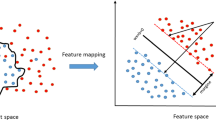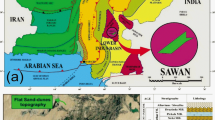Abstract
Vuggy porosity is a key pore space type associated with the characterization of any carbonate reservoir. This porosity has significant influence on many parameters in reservoirs such as permeability, oil recovery, pressure drop and production. In this paper, two data-driven methods (i.e., Bayesian and Parzen classifiers) are used to identify vuggy porosity zones from well logs. Four well logs namely gamma ray (GR), neutron porosity (NPHI), bulk density (RHOB) and sonic (DT) from three oil wells drilled in Sarvak Formation, west of Iran, were integrated to examine the capability of the methods. The results show that the Parzen classifier gives better results than Bayesian in terms of classification accuracy. The Parzen technique classifies the given depth with an average accuracy of 77.7 % in single-well analysis and average accuracy of 67.3 % in generalization step.



Similar content being viewed by others
References
Aguilera RF, Aguilera R (2004) A triple porosity model for petrophysical analysis of naturally fractured reservoirs. Petrophysics 45(2):157–166
Bize E (2006) Case study of permeability, vug quantification, and rock typing in a complex carbonate. SPE 102888
Burrus CS, Gopinath RA, Guo H (1997) Introduction to wavelet and wavelet transforms: a primer. Prentice-Hall, New Jersey
Choquette PW, Pray LC (1970) Geologic nomenclature and classification of porosity in sedimentary carbonates. AAPG Bull 54:207–250
Duda RO, Hart PE, Stork DG (2000) Pattern classification, 2nd edn. Wiley-Interscience, NY
Gomaa N, Al-Alyak A, Ouzzane D, Saif O, Okuyiga M, Allen D, Rose D, Ramamoorthy R, Bize E (2006) Case study of permeability, vug quantification and rock typing in a complex carbonate. In: Proceedings of the SPE annual technical conference and exhibition, San Antonia, TX, USA
Grossmann A, Morlet J (1984) Decomposition of hardy functions into a square integrable wavelets of constant shape. SIAM J Math Anal 15:723–736
Hurley NF, Zimmermann RA, Pantoja D (1998) Quantification of vuggy porosity in a dolomite reservoir from borehole images and core, Dagger Draw field, New Mexico. SPE 49323. In: Proceedings of the SPE annual technical conference and exhibition, New Orleans, USA, 27–30 Sept 1998
Lucia FJ (1983) Petrophysical parameters estimated from visual descriptions of carbonate rocks: a field classification of carbonate pore space. J Pet Technol 35(3):629–637
Lucia FJ (1995) Rock- fabric/petrophysical classification of carbonate pore space for reservoir characterization. AAPG Bull 79:1275–1300
Mengual JF, Recinos LM, Ho ES, Hernández FG (2000) Formation evaluation in southern Mexico’s low-porosity fractured carbonate rocks using imaging and NMR tools. In: Transactions of the SPWLA 41st annual logging symposium
Perez-Rosales C, Mercado-Diaz A, Cruz-Hernandez J, Islas-Juarez R (2002) Electric resistivity of vuggy fractured media. SPE 74340
Pinous O, Zellou A, Robinson G, Royer T, Svikhnushin N, Borisenok D, Blank A (2007) Continuous fracture modeling of a carbonate reservoir in West Siberia. SPE 103284
Towle G (1962) An analysis of the formation resistivity factor-porosity relationship of some assumed pore geometries. In: Paper C presented at Third Annual Meeting of SPWLA, Houston
Acknowledgments
The authors would like to express their sincere thanks to the Exploration Directorate of National Iranian Oil Company (NIOC) for their assistance in providing data and information.
Author information
Authors and Affiliations
Corresponding author
Rights and permissions
About this article
Cite this article
Mollajan, A., Asgarinezhad, Y., Tokhmechi, B. et al. A comparative study of two data-driven methods in detection of vuggy zones: a case study from a carbonate reservoir, west of Iran. Carbonates Evaporites 30, 181–185 (2015). https://doi.org/10.1007/s13146-014-0201-x
Accepted:
Published:
Issue Date:
DOI: https://doi.org/10.1007/s13146-014-0201-x




